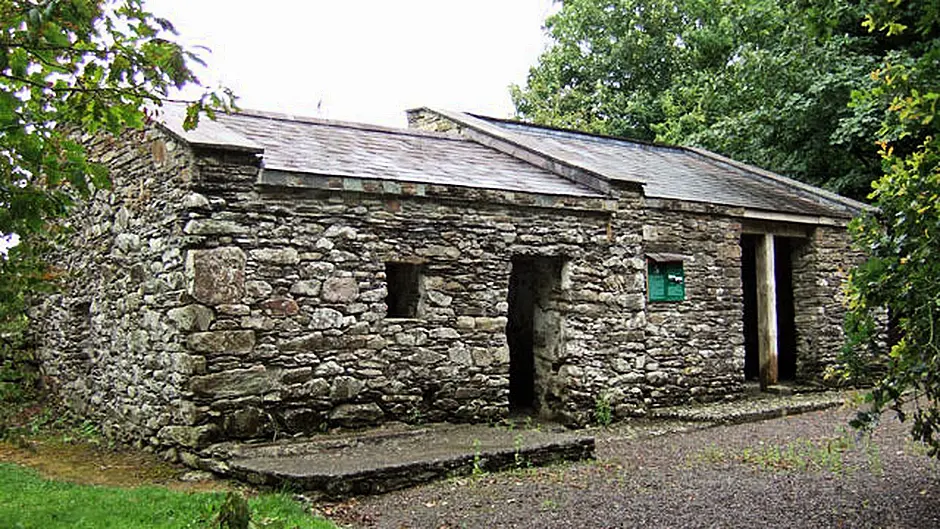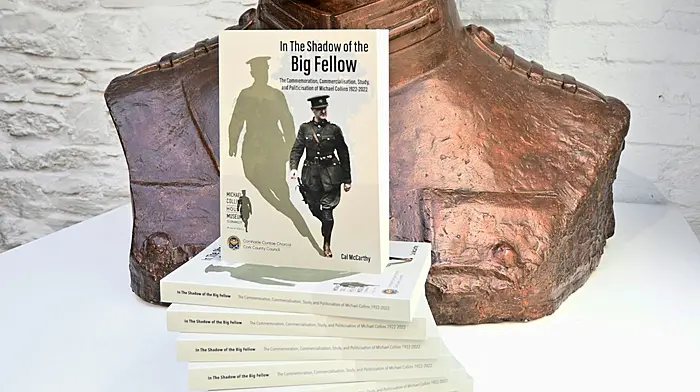This article originally appeared in our special 2022 supplement marking the centenary of Michael Collins' death – read the full supplement via southernstar.ie/epaper.
Coming from humble beginnings in West Cork, the talented military strategist went on to be part of a team that put the first cracks in the British empire.
THE words of Ralph Waldo Emerson were used by the Hollywood actor Liam Neeson to describe how Michael Collins was – to use the vernacular – ‘his own man’.
It would take an actor of the stature of Liam Neeson to convey on screen a sense of who and what Michael Collins was in life and why his death made such a mark on our history.
Emerson observed it is tragic how few people ever possess their souls before they die. ‘Nothing is more rare in any man,’ said Emerson, ‘than an act of his own.’
Liam Neeson – who played Michael Collins in the eponymous film in 1996 told an assembly at Emmet Square in Clonakilty in 2002 – ‘Michael Collins is my hero. He inspires me still.’
It was strange and very gratifying to hear the Hollywood star say: ‘If my presence here in any way helps to keep alive his memory, then I am doubly honoured.’
A few years before the Neil Jordan movie another Liam –Liam Collins, a nephew of the great man was responsible for reclaiming the overgrown Woodfield homestead and making it a natural, almost spiritual, memorial park. A year after the movie came out, a distant relative, Tim Crowley, set about doing tours of locations associated with Michael Collins, the revolutionary leader who led a guerrilla army against the UK, helped negotiate the creation of the Irish Free State, and led the pro-Treaty army in the Irish Civil War.
On one of the first coach trips, 40 people came to see the preserved footprint of the old farmhouse at Woodfield.
Among them was Joan Collins Bunworth, a niece of Michael Collins who, at 70 years of age, was able to throw her mind back 60 years to the time a British army sergeant stood menacingly in the small dwelling.
She said he made his brutal presence felt by using the barrel of his rifle to tip a grandfather clock to the floor, where he then ensured its destruction by smashing it with the butt.
Thirty of the 40 people on that bus tour subsequently wrote to Tim to say how fortunate they felt to be in the presence of living history.
History buffs – including teenagers who have been known to petition their parents to holiday in Clonakilty want to walk where Michael Collins once walked.
 Actor and Collins fan Liam Neeson as the Clonakilty man, giving one of his impassioned speeches, in the movie Michael Collins.
Actor and Collins fan Liam Neeson as the Clonakilty man, giving one of his impassioned speeches, in the movie Michael Collins.
Visitors come to do ‘the trail’ and to take it all in. Invariably they go from Tim and Dolores Crowley’s Michael Collins Centre museum off the Timoleague Road, to Woodfield near Sam’s Cross, three miles west of Clonakilty, and the Michael Collins House Museum at Emmet Square.
Even those who leave out the talks, the walks, the presentations, and the poring over artefacts, can feel the connection when they look at the remarkable bronze bust of Michael Collins at Woodfield, or the statue that towers over Emmet Square.
The bronze statue – fixed on a large stone plinth – appears to be in motion and is therefore a good representation of the complexities of the man, and the myth.
According to Tim Crowley, who wrote In Search of Michael Collins, much of the fascination has to do with the fact that Collins is viewed as ‘the complete package’.
‘He was good looking, charismatic and ruthless when he needed to be – a bit of a genius in many ways, and a visionary,’ he said.
Neil Jordan’s historical biopic of the Irish revolutionary – the man who led a guerrilla war against the UK, helped negotiate the creation of the Irish Free State, and led the National Army during the Irish Civil War – has sparked the interest of international visitors, too.
They marvel at the juxtaposition of his humble origins at Woodfield – a place that had been used as a sty for pigs in the 1970s – to him sitting across the table from Winston Churchill and David Lloyd George at 10 Downing Street in London where he helped to negotiate a huge level of independence for his country.
‘Then,’ said Tim, ‘having achieved so much power, and being so successful, to end up being killed at Béal na Bláth, just 30km from his birthplace, is part of the tragic story.’
In the thousands of tours he has done, Tim said there were three occasions when tourists approached him and told him they had scattered the ashes of a loved one at Woodfield.
‘They were no relation, they had no blood ties, but they still felt a bond with Michael Collins,’ said Tim.
‘As a historian, I find his story amazing. He came from humble beginnings and went to school here locally. At the age of 15-and-a-half, he left West Cork and went off to London to work and spent almost 10 years working there, until 1916. ‘He came back here and fought in the rebellion in Dublin in 1916, but was barely noticed at that stage because he was just a captain in the volunteers.
‘Then,’ said Tim, ‘he rose to the top of the IRA and Sinn Féin in 1917 and 1918, basically spearheading the War of Independence against the British.
‘We know he used military means – violence against the British – and that he was a genius at military tactics, guerrilla warfare especially.
‘But he didn’t really like using violence and the first chance he got – when he thought that military means had taken the situation as far as it could go – he was willing to agree to a truce, to compromise and negotiate with the British, and was one of the leaders who signed the Anglo-Irish Treaty of 1921.
‘I have signed a Treaty of peace between Ireland and Great Britain,’ Arthur Griffith, one of the co-signatories wrote. ‘I believe that Treaty will lay foundations of peace and friendship between the two nations. What I have signed I shall stand by in the belief that the end of the conflict of centuries is at hand.’
Michael Collins is, of course, famously on record as having said the signing of the Treaty was the signing of his death warrant.
His comment foreshadowed how the Treaty would lead to civil war, a war in which he became the commander-in-chief of the pro-Treaty army.
‘About two months into the war,’ Tim Crowley said, ‘he came down to West Cork on a tour of inspection and was killed about a half-hour’s journey from where he was born.’
But there is another parallel in the pain of proximity.
‘As the closest colony to the British mainland, Collins and his compatriots were able to put the first crack in the British empire,’ said Tim.
‘They were able to force the British to relinquish control. It was a huge achievement that led to so many countries all over the world being able to gain their independence from Britain.’










